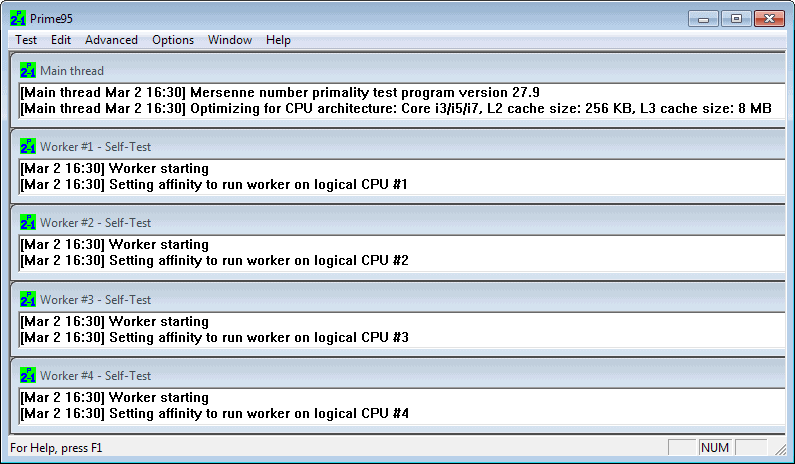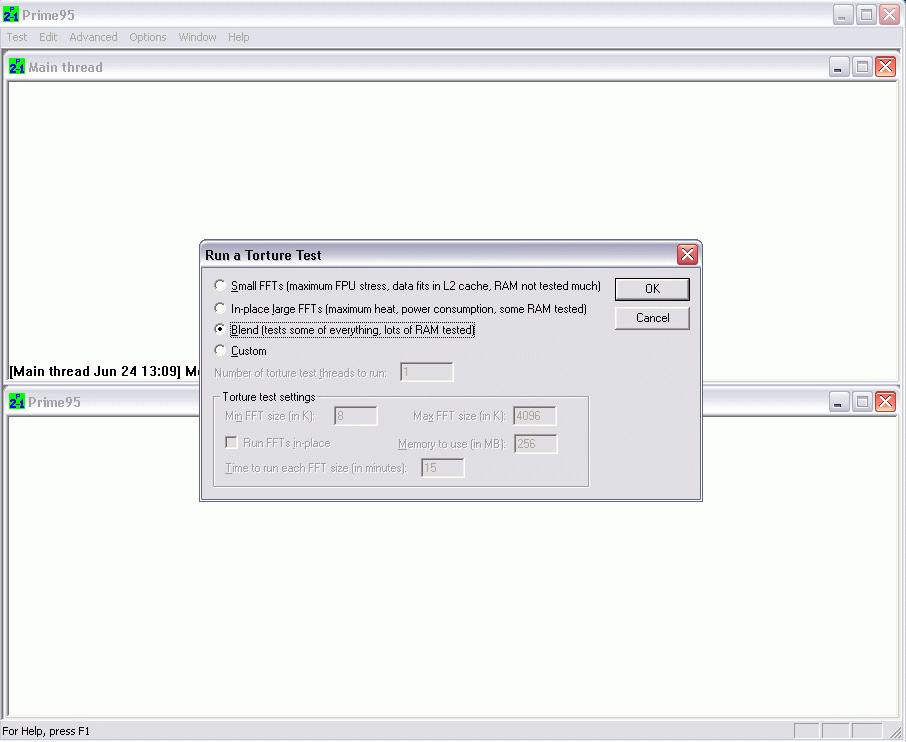
- Prime95 cpu stress test how to#
- Prime95 cpu stress test install#
- Prime95 cpu stress test software#
- Prime95 cpu stress test Pc#
- Prime95 cpu stress test download#
Prime95 is one of the most popular CPU stress testing tools out there.
Prime95 cpu stress test how to#
Here, we’ll show you how to use some of the best tools to stress test your PC. These all work similarly to one another, with minor differences. Our recommended CPU stress testing tools are Prime95, AIDA64, HeavyLoad, and Intel BurnTest. What are the best tools for a CPU load test? Monitor your CPU temperatures: Don’t let your CPU temperature exceed 90☌ for prolonged periods. Sleep Mode will detect unnecessary programs and temporarily deactivate them to ensure your test delivers the most accurate results possible.

Open AVG TuneUp, go to Speed Up, and click Background & startup programs.
Prime95 cpu stress test Pc#
AVG TuneUp's Sleep Mode technology puts those programs to sleep and halts all background activity, ensuring that your PC devotes all its resources to the CPU stress test.
Prime95 cpu stress test install#
Closing these programs and processes is a great way to speed up your PC.ĭownload and install AVG TuneUp to identify any programs wasting RAM and CPU resources. Background and foreground processes can interfere with the CPU stress test. Here’s how:Ĭlose all nonessential applications. To make sure your CPU stress test runs properly, prepare your PC by shutting down any programs that won’t be used during the test. How to prepare for a computer stress test? It’s important to perform a CPU stress test before overclocking your CPU - otherwise, you might push things too far. The results of your computer stress test will give you an idea of your PC’s overall health and stability. Run the stress test while monitoring your CPU temps.
Prime95 cpu stress test download#
Prepare your computer for a stress test by closing all nonessential apps and checking your CPU temperature.Ĭhoose and download a stress testing tool. How do I stress test my PC?įollow this procedure to stress test your PC: The only utilities I've ever found that come as close as possible to 100% TDP are Prime95 v26.6 Small FFT's for thermal testing, which is a steady workload, and Asus RealBench for stability testing, which is a fluctuating workload.Īlthough the topic of Prime95 (with and without AVX) was covered, I would like to have seen RealBench included in your test suite, as it's widely accepted as an excellent utility for testing overall system stability, and uses a realistic AVX workload.We’ll show you how to use the most popular PC stress testing tools, then explain how stress testing helps maintain your computer’s health. However, since Intel validates their thermal specifications at a steady 100% TDP, it's most appropriate to select utilities that don't overload or underload the CPU.

This article provides some excellent comparisons.

Prime95 cpu stress test software#
Since most users test their rigs without a sense of scale for power and temperature, they can't compare apples to apples, especially when combined with major variables such as differences in ambient temperature, hardware configurations and software utilities. Otherwise, great work! I was very pleased to read this article!Ģ0741319 said:As the author of the Intel Temperature Guide - I can fully appreciate how much work went into creating this outstanding article, which has been sorely needed! The only utilities I've ever found that come as close as possible to 100% TDP are Prime95 v26.6 Small FFT's as a steady workload for thermal testing, and Asus RealBench as a fluctuating workload for stability testing.Īlthough the topic of Prime95 (with and without AVX) was covered, I would like to have seen RealBench included in your test suite,since it's widely accepted as an excellent utility for testing overall system stability, and uses a realistic AVX workload. Nevertheless, our results are very similar. The Intel Temperature Guide differs in its approach toward the topic of processor Core temperatures and cooling with respect to Intel's TDP specifications, and distinguishes between steady workloads for thermal testing versus fluctuating workloads for stability testing. This article provides a perspective and some excellent comparisons. As the author of the Intel Temperature Guide - I can fully appreciate how much work went into creating this outstanding article, which has been sorely needed!


 0 kommentar(er)
0 kommentar(er)
